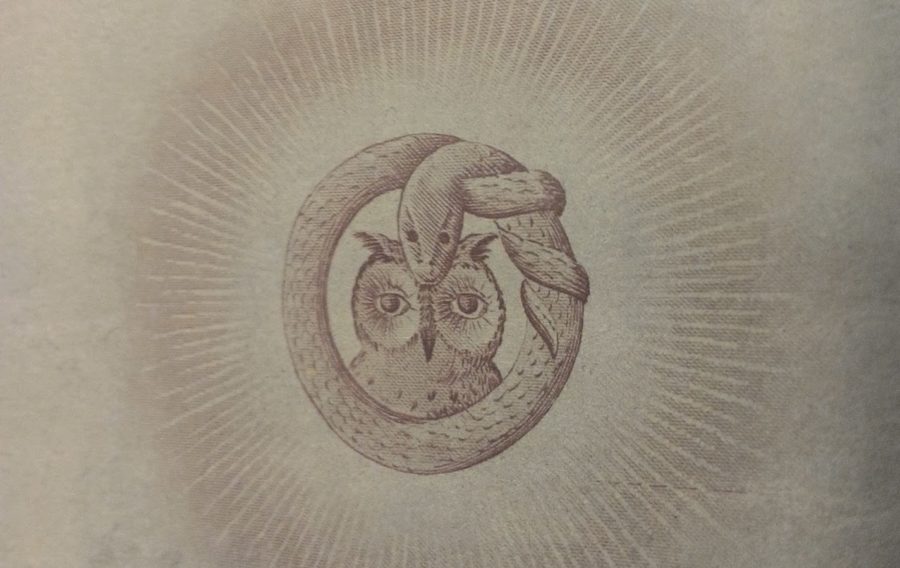This past weekend marked the 50th reunion of the Class of 1967, the last class to recruit new members for the University of Chicago’s only known secret society, “The Society of the Owl and Serpent.” Although the existence of the Owl and Serpent may not be common knowledge on campus today, in its over 70 years of recorded existence, it had a number of illustrious members, most notably retired Supreme Court justice John Paul Stevens (A.B. '41).
When it was founded in 1896, the Owl and Serpent was only one among many secret societies springing up across the country. In the late nineteenth century, a spate of new secret societies were formed at schools including Harvard, Yale, the University of Virginia, Stanford, Dartmouth, and the University of California.
Institutional attitudes toward secret societies varied. While secret societies became a normal part of college life on the East Coast, the faculty and administrators of the University of Chicago signed a joint resolution in 1892 setting forth a number of difficult rules any secret society would have to follow and expressing concerns about the negative ways secret societies could influence campus life. As reported by the Harvard Crimson, the guidelines required that all fraternal organizations submit their house rules to faculty for approval and appoint a faculty representative. Taken together, the rules effectively preempted any possible administrative recognition or support for any secret organization on campus.
Facing an academic and administrative climate hostile to secret societies, all current and former living members of the Society of the Owl and Serpent jointly decided to go public in 1913, and began a correspondence with the administration about securing a permanent home for the organization. By 1915, the Society of the Owl and Serpent had secured a meeting place, and by the 1920s functioned like the other senior societies on campus, publicly taking pledges from the rising junior class, and even circulating a print magazine.
Relatively little is recorded about the Society of the Owl and Serpent in the period between 1920 and 1968. Written evidence from profiles and alumni show that membership in The Society of the Owl and Serpent was publicly treated as a badge of merit and like membership in any other honor society. It is not known, however, if the Society of the Owl and Serpent ceased all clandestine activity once knowledge of it became public.
The formal end to the Society of Owl and Serpent came in 1968, when, as a sign of its counter-culture values, the Society of Owl and Serpent voted to disband itself and leave its meeting place to the radio club, WHPK, and allocate its remaining funds towards the purchase of an FM transmitter.
Since 1968, there have been sporadic rumors of the continuation of the The Society of the Owl and Serpent, as well as the existence of various other secret societies on campus. Last month, for example, the appearance of a strange poster on campus featuring zodiac signs caused some amount of confusion.
While many students assumed that the poster was a puzzle intended as prelude to Scav, Scav judge Dan Cohen told a Maroon reporter that it the zodiac code was in no way officially affiliated with Scav. “Many people approached me about a 'code item' I had created for Scav, but I was anxious to tell them they were going down the wrong trail," he said.
Recently, sightings of masked figures on campus have also added to campus speculation that a new secret society has arisen. Any such speculation, however must be regarded with cautious scepticism. The number and diversity of on-campus activities can make it hard to tell whether something is a piece of art, a puzzle, an in-joke, or evidence of something else entirely.
Nonetheless, recent events have provided an inspiration for a few to look back in the archive towards this fascinating piece of University of Chicago history from which there is much to learn. The longevity of the Society of the Owl and Serpent is a testament to its ability to change with the times and circumstances. Its shift from a secret organization catering to a small audience, to an honor society, to a progressive organization taking part in leftist foment on campus shows an astounding level of breadth. Looking back on alumni weekend, its story can serve as an inspiration for how to continue traditions across generations in an ever-changing institution. In times of such uncertainty, it serves as a reminder of both how a tradition can carry on for decades and how a single generation can sometimes institute sweeping change—in this case, changes that fans of WHPK surely appreciate.
Categories:
Remembering the Society of the Owl and Serpent
The Society of the Owl and Serpent disbanded 50 years ago in 1967. The Maroon looked back on its storied past.
By Daniel Lipson, Contributor
June 9, 2017
1
0
Donate to Chicago Maroon
$10000
$10000
Contributed
Our Goal
Your support will ensure that we can continue producing powerful, honest, and accessible reporting that serves the University of Chicago and Hyde Park communities.
More to Discover










Seth Masia / Sep 22, 2023 at 1:09 pm
In the spring of 1969 someone informed me that I’d been elected as one of three members of the Owl & Serpent for the Class of ’70, and handed me a key to a cubbyhole “clubhouse” in Mandel Hall. I don’t recall who the other members were, and we did nothing that year, but we had at least one meeting to elect our successors for the Class of ’71. I nominated Kathy Atlass and she was duly elected. Electing a woman may have been the last straw for the Society.